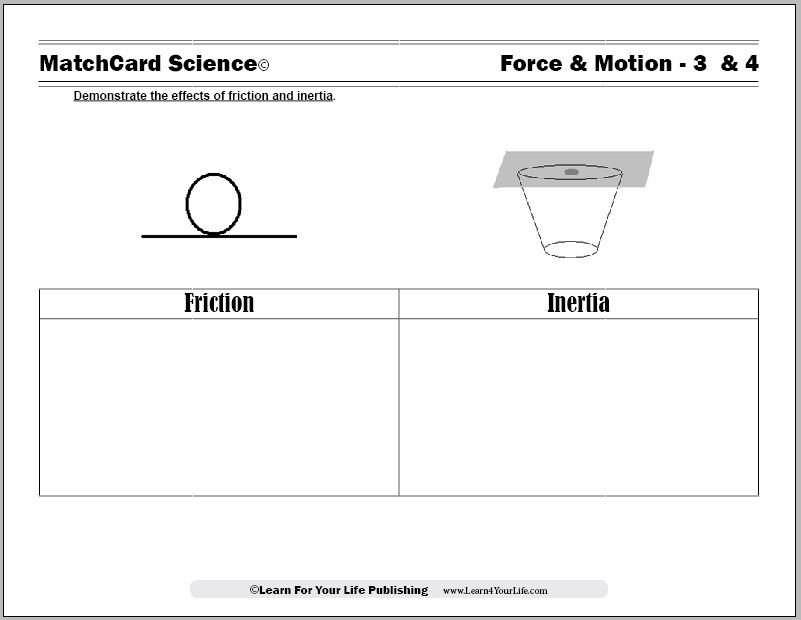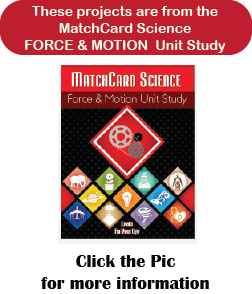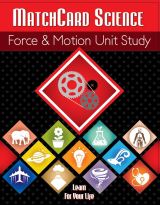Friction and Inertia
Study friction and inertia from the MatchCard Science Force and Motion Unit Study.
Free Download Below


Friction And Inertia MatchCard
Objective: Demonstrate the effects of friction and inertia.MatchCard: Download below.
This lesson includes the definitions and common examples of inertia and friction on the MatchCard information pieces.
Projects: Skate, slide, and scrape your way to understanding friction. Ride in a car or wagon to understand both effects of inertia. Pull an old card trick on inertia.
Download and Use the Friction and Inertia MatchCard


This is MatchCard #3 & 4 of the Force and Motion Unit Study. You can find more information on MatchCard Science below.
What Is Friction?
Friction is resistance to a moving object.Friction is caused by one surface touching another. Ask the student if it would be easier to roller skate on a smooth roller skating rink, or a gravel road. Why?
Here is a simple hands-on demonstration of friction:
- Get a marble or small ball
- Plan to use a number of different types of surfaces to roll the marble on
- Carpet
- Rubber mat
- Concrete
- Felt
- Wooden floor
- Linoleum
- Start by rolling the ball across two obvious examples: like linoleum and a carpet.
- Have the students estimate which surfaces would have more friction. First guess by looking, then by touching.
- Roll the marble across all of them.
- Roller skating, roller blading, or skateboarding: what surface do you like best?
- "Skate" with your socks across a hard floor. What socks work best? Which floors?
- Ice anyone? Why IS it so slippery. (no friction)
- Why do bowling alleys and skating rings NOT want you to wear streets shoes on their floors?
- Pinewood derby races put graphite in the wheels. Why? Try rolling a toy car before and after applying graphite to reduce friction.
More Examples of Friction
Rubbing your hands together to produce warmth, scraping the windshield to remove frost, and applying brakes to slow down a car or bike are other common examples.Brainstorm a list of other examples of friction. Encourage students to identify examples of friction in daily life over the weeks they are studying Force and Motion.
What Is Inertia?
There are two parts to the definition of inertia:1. The tendency of a moving object to continue moving at the same speed and direction
Discuss what happens when you are riding in a car and the brakes are applied suddenly. Act out the motion of lurching forward.Ask them why they think that happens.
If you have a small wagon or toy on wheels demonstrate that effect. Put a stuffed animal in the wagon, push the wagon to get it moving, and then use your foot to stop the wagon suddenly. The stuffed animal should fly forward.
Inertia caused the animal to go forward. The wagon stopped, but the toy did not.
2. The tendency of an unmoving object to remain stationary
Here's a popular demonstration of inertia:- Put an index card on a cup.
- Put a dice or coin on top of the card.
- Quickly pull the card out from under the object.
Vocabulary
"Friction" and "inertia" are scientific concepts described above. But sometimes people use these terms to describe in human events.Have you ever heard of "friction" when there is a disagreement? How does that compare to friction between objects?
Sometimes when someone is not motivated, they will call that "inertia." Why?
MatchCard Science
How To Use MatchCards

Download the FREE MatchCard Science Instructor's Guide and see how MatchCards can make building their science knowledge base fun.
Force & Motion Unit Study

It will take four to six weeks to complete the seven objectives in this Unit Study.
Download the entire Force And Motion Unit Study.
12 Science Unit Studies

Chemistry is only one of twelve complete unit studies for kids in 3rd to 8th grade.
Comprehensive objectives, hands-on projects, suggested science fair experiments, and the fun game-like MatchCards keep them interested in learning science. See all twelve MatchCard Science Unit Studies.
About Our Site
Hands-On Learning













